Fewer Crabs -- Fewer Fish
Glen Sutton, Galveston Bay Biologist
Texas blue crab populations have declined significantly in the last few years. In fact, last year's harvests were the lowest ever recorded. Only 3.1 million pounds were landed, an amount well below the historic average of 6.3 million and nowhere near the 11.9 million pounds landed in 1987. Under normal circumstances, these landings generate around $12 million annually for coastal economies: when landings decline not only do the crabbers suffer, but so do their communities. There also are implications for sportfishing; a lot of fish feed on the juvenile blue crabs. So what is causing this decline and how will it affect fishing?

Being the most affected, crabbers have their own perspective. "We need to ensure that fresh water keeps flowing into our bays each year; that's when crabbing is at its best", says a large seafood dealer from the upper coast. "Crabbers down in Brownsville won't see a crab at all when things dry up". This reference is to the Arroyo Colorado, which empties out into the lower Laguna Madre. In the dry season reduced rainfall and upstream usage takes its toll -- reducing inflow to the Laguna to almost nothing. This effect has also been observed and documented in other coastal estuaries across the Gulf of Mexico.
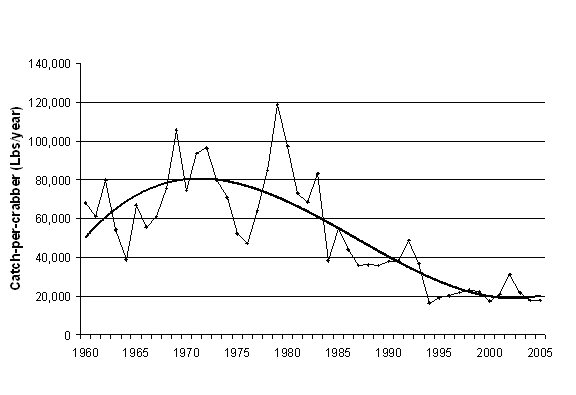
Overharvesting crabs is another problem. Landings decline when yields exceed a certain level, namely the maximum sustainable yield. Recently, biologists Tom Wagner and Glen Sutton (TPWD Coastal Fisheries) have been analyzing twenty-six years of commercial blue crab data. Clearly, catch rates have been declining since the mid 1980's. Stocks were overexploited during the early 1980s, which reduced them to a low level. When populations are severely reduced, the low level minimizes reproduction and recovery is slow. Then in 1997, a limited entry program was initiated by the Texas Legislature. This was the second program of its kind after the shrimp trawl limited entry program was introduced in 1995. Now, with crab trap limited entry entering its sixth year, effort has been reduced by approximately 20%. This appears to be helping reduce overharvest and there are some signs that a slow recovery is taking place. Figure 1 shows how the annual catch-per-crabber has changed since the 1960's and leveled off since limited entry.
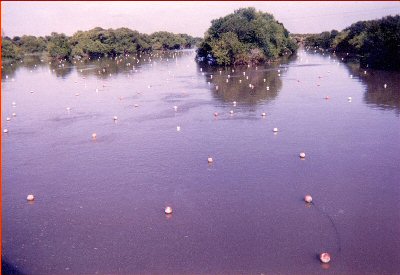
Marsh, seagrass beds and wetlands are crucial for blue crabs to flourish. Juveniles avoid predation by seeking refuge in these habitats and a symbiotic relationship develops between them and the vegetation. Crabs strip the aquatic vegetation of grazing mollusks and in turn are provided with extra cover and food -- circumstances under which strong recruitment is almost guaranteed. Unfortunately, these habitats are continually threatened. From the mid 1950's to 1979 approximately 35% of Texas coastal wetlands (325,640 acres) were lost to development and population expansion (Texas General Land Office, 1996). We know that quantifying direct impacts is difficult; however it would be safe to say that while stocks can be managed for sustainability using several different methods, natural habitat once lost is gone forever and not easily replaced.
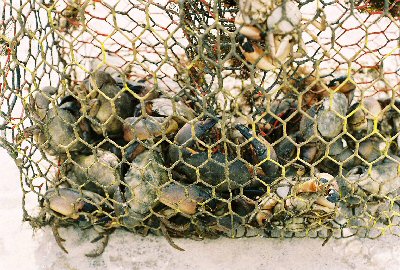
The key to understanding the implications of reduced crab stocks is to examine predator-prey interactions within the estuarine food web. Whenever abundance of one species is reduced for whatever reason there are repercussions throughout the ecosystem. These manifest themselves in unexpected patterns, reducing the quantity of one species, while increasing the numbers of another. Blue crabs provide an indispensable food source for many estuarine inhabitants by converting detritus and other organic material into edible biomass. They also constitute a critical food source for many recreational finfish species such as sheepshead, black drum and red drum. When blue crab populations are depleted, an important food source is lost. Figure 2 shows how blue crab biomass has declined over time (TPWD resource data).
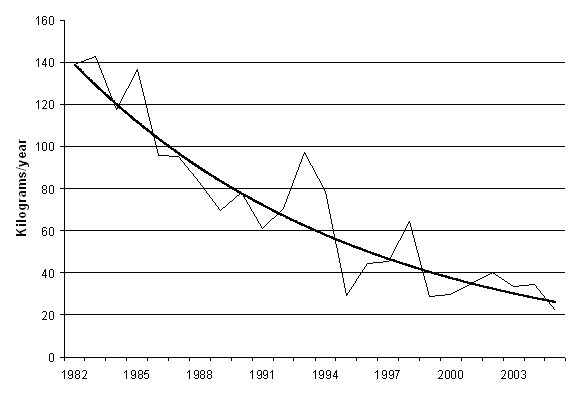
To illustrate this point, think about the effects of a prolonged drought without water restrictions. It starts with less freshwater flowing into the estuary. This is followed by reduced primary productivity (growth of algae, seagrass, and phytoplankton). This reduction limits the food supply for organisms at the lower levels of the food chain (zooplankton, mollusks), which in turn limits the food supply of blue crabs. Such a sequence leads to fewer crabs for the fish to eat and ultimately less and smaller sport fish for the recreational fisherman. Figure 3 shows relevant links in the blue crab food web.
Causes for declining blue crab populations are many and so are the implications for management. Human activities and ecological processes occur simultaneously in open access resources such as our own. This not only adds to the complexity, but also puts a lot of responsibility on all of us. In a sense, we become a larger part of the ecosystem and everything we do has an impact. Coastal Fisheries staff are in the process of developing ecosystem-based models to better understand and quantify the impacts of ecological disturbances. These models will allow better management of the commercial blue crab fishery and establish better angler opportunities for recreational fishermen. Certainly, reviving the blue crab stocks will ensure better fishing in the future.
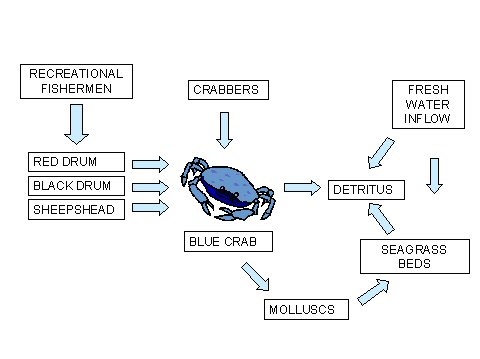
© Copyright Texas Parks and Wildlife Department. No part of this work may be copied, reproduced, or translated in any form or medium without the prior written consent of Texas Parks Wildlife Department except where specifically noted. If you want to use these articles, see Site Policies.